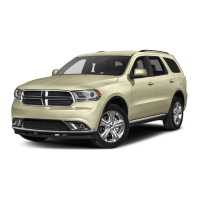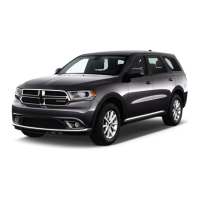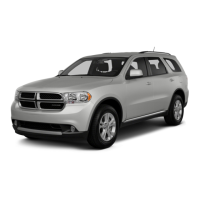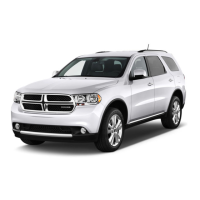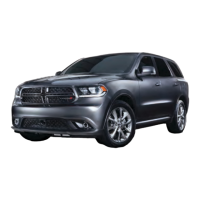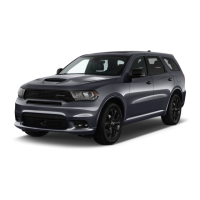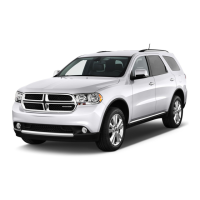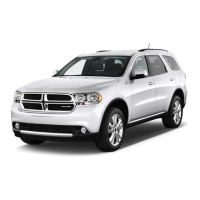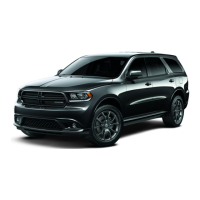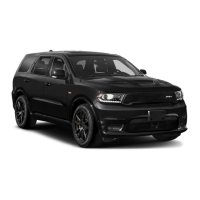
Do you have a question about the Dodge Durango 2012 and is the answer not in the manual?
| Brand | Dodge |
|---|---|
| Model | Durango 2012 |
| Category | Automobile |
| Language | English |
Provides an overview of the vehicle and its features.
Highlights the higher rollover risk of utility vehicles and safe driving practices.
Explains the importance of reading warnings and cautions for safety and vehicle protection.
Details the location and importance of the VIN for vehicle identification and equipment records.
Warns that modifications can affect vehicle roadworthiness, safety, and lead to collisions or death.
Explains the keyless ignition system, key fob, and wireless ignition node (WIN) operation.
Describes the Sentry Key Immobilizer system for preventing unauthorized vehicle operation.
Details how the vehicle security alarm monitors doors, liftgate, and ignition for unauthorized operation.
Explains how courtesy and approach lights turn on when using the remote keyless entry or opening doors.
Describes the system for locking/unlocking doors and liftgate, and activating the panic alarm remotely.
Covers manual and power door lock operation, including child-protection systems.
Details power window operation, including auto-down and anti-pinch features.
Explains how to open and close the liftgate, including power liftgate operation.
Outlines the vehicle's restraint systems, including seat belts, airbags, and head restraints.
Provides guidelines for breaking in the engine and drivetrain for optimal performance and longevity.
Offers general safety advice, including transporting passengers and handling exhaust gas.
Covers inside day/night mirror, automatic dimming mirror, and power mirror adjustments.
Explains the system that uses sensors to detect vehicles in blind spot zones for enhanced driving safety.
Describes the feature that aids drivers when backing out of parking spaces by detecting oncoming vehicles.
Details the voice-activated, hands-free vehicle communication system for mobile phones.
Explains how to control vehicle functions like radio and phone using voice commands.
Covers power and manual seat adjustments for driver and passenger comfort and positioning.
Details the operation of eight-way power driver and front passenger seats and their controls.
Explains the heated seat feature for comfort in cold weather, including operational notes.
Describes the ventilated seat feature that circulates air to keep occupants cooler in warm weather.
Explains the function of head restraints in reducing neck injury risk during rear impacts and their adjustment.
Provides an overview of the vehicle's dashboard layout and component locations.
Details the various gauges and indicators within the instrument cluster.
Explains the driver-interactive display for system status, warnings, and settings.
Lists and describes the meaning of white caution telltales displayed in the EVIC.
Lists and describes the meaning of amber caution telltales displayed in the EVIC.
Lists and describes the meaning of red telltales displayed in the EVIC.
Explains how to monitor average fuel economy and distance to empty via the EVIC.
Describes how to monitor the vehicle's speed on the EVIC display and change units.
Guides on adjusting seats, mirrors, seat belts, and instructing occupants before starting.
Details precautions for shifting the automatic transmission to prevent damage.
Explains how to operate the ignition switch using a push button and fob.
Provides instructions for starting a cold or warm engine without pedal input.
Recommends using an engine block heater for reliable starting in extreme cold.
Offers troubleshooting steps for engine starting issues, including jump-starting precautions.
Explains the function and installation of the engine block heater for cold weather starts.
Describes the operation of the electronically shifted transfer case and its modes.
Details the electro-hydraulic power steering system and precautions for its use.
Explains the operation and importance of the foot-operated parking brake.
Covers ABS, TCS, BAS, ERM, and ESC systems for vehicle stability and control.
Provides safety tips, limits, and definitions related to towing trailers with the vehicle.
Explains how to use hazard flashers for signaling an emergency or disabled vehicle.
Provides steps to reduce overheating potential and cautions regarding hot engine components.
Details safety warnings and instructions for safely changing a tire using the vehicle's jack.
Offers procedures and warnings for safely jump-starting a vehicle with a discharged battery.
Explains the rocking motion technique to free a vehicle stuck in snow, sand, or mud.
Locates and describes the use of emergency tow hooks for off-road recovery.
Provides instructions to manually move the shift lever if it cannot be moved from PARK.
Describes procedures for towing disabled vehicles using wreckers or dollies.
Identifies components and reservoirs in the engine compartment for the 3.6L engine.
Identifies components and reservoirs in the engine compartment for the 5.7L engine.
Explains the OBD II system, Malfunction Indicator Light (MIL), and emissions testing readiness.
Discusses legal requirements for emissions inspections and system readiness checks.
Recommends using genuine MOPAR parts for optimal performance and to maintain warranty.
Emphasizes the benefits of using authorized dealers for expert service and specialized tools.
Outlines required maintenance services for vehicle longevity and performance.
Details how to check engine oil level, recommended viscosity, and oil change intervals.
Recommends using high-quality filters for efficient service and proper engine protection.
Advises on the importance of engine air cleaner filters for efficient service.
Explains the features of the maintenance-free battery and safety precautions.
Recommends regular checks and servicing of the air conditioner for optimal performance.
Details periodic lubrication of locks, pivots, hinges for quiet operation and rust protection.
Provides guidance on cleaning and maintaining wiper blades for optimal performance.
Explains how to check and refill washer fluid, noting the shared reservoir.
Emphasizes maintaining the exhaust system to prevent carbon monoxide entry.
Warns about hot engine coolant and provides instructions for checking and maintaining the cooling system.
Stresses the importance of inspecting brake system components for performance and safety.
Lists approximate fluid capacities for the vehicle's various systems in U.S. and Metric units.
Outlines scheduled maintenance services to protect warranty and ensure vehicle performance.
Refers to subsequent pages for detailed required maintenance intervals based on mileage or time.
